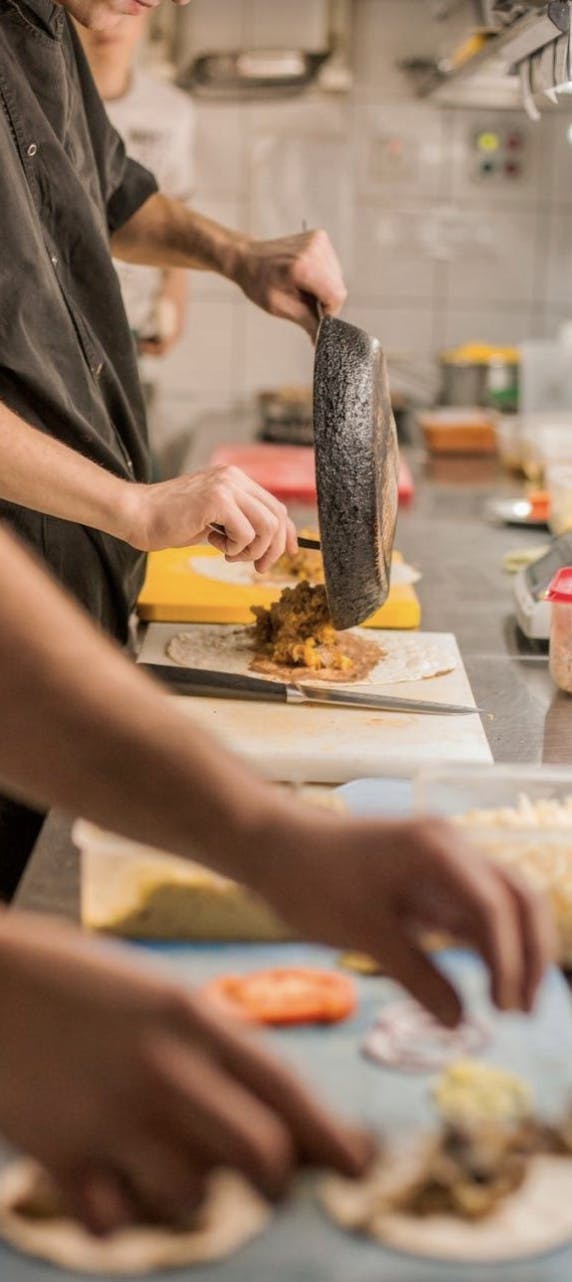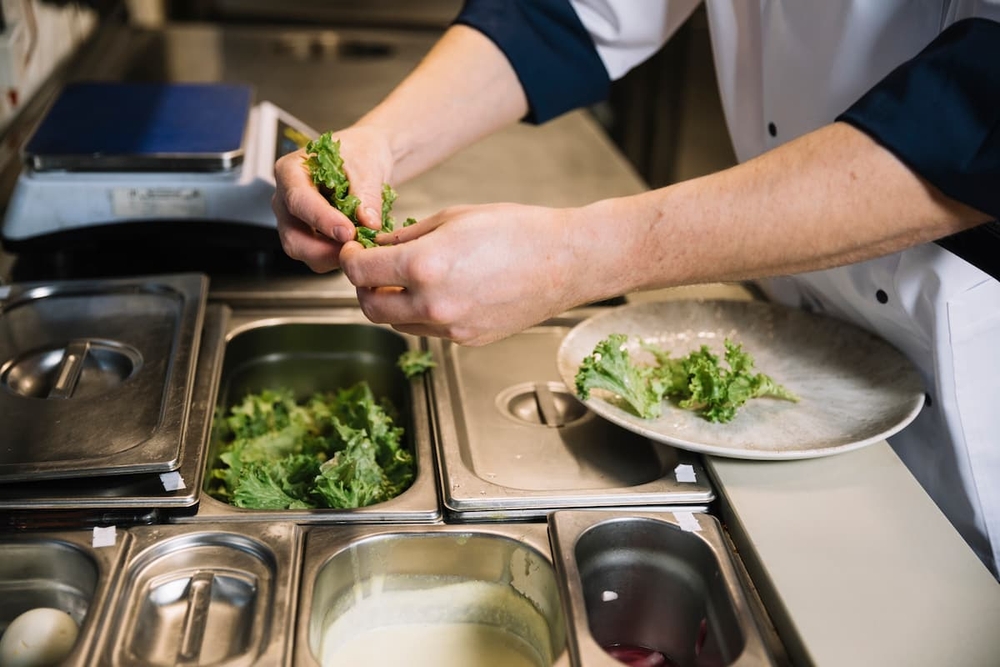How to manage food production for Independence Day catering success
Table of Contents
CloudKitchens
How many tacos can be delivered from a 1000sqft restaurant?
The same amount as a 200sqft ghost kitchen.
Independence Day is more than fireworks and flags — it’s a celebration of community, summer, and, of course, food. With over 65% of Americans expected to host or attend a 4th of July cookout, this holiday represents one of the busiest and most profitable days of the year for catering companies and commercial kitchens in the USA.
Managing food production for this high-demand event requires careful planning, seamless operations, and a creative menu tailored for patriotic appetites. From classic BBQ fare to modern twists on traditional dishes, bulk food preparation must be efficient, consistent, and festive. In this guide, we’ll show you how to manage food production for Independence Day catering while keeping quality high and waste low.
Understanding 4th of July catering demand
The 4th of July is one of the top five food holidays in the United States. According to the National Retail Federation, over 80% of Americans celebrate with food and drinks, typically through cookouts, picnics, or outdoor events. The demand for catering skyrockets, especially in cities hosting parades or fireworks shows.
Food production for Independence Day must meet:
- High-volume order fulfillment (often 100+ servings per item);
- Outdoor-friendly packaging and storage;
- Dietary preferences like vegetarian or gluten-free;
- Logistics coordination for delivery or on-site service.
A proactive approach to bulk food prep, staffing, and scheduling can make or break your success.
Read more: Turn festive celebrations into profits with holiday catering
Popular Independence Day menu items
The key to catering on Independence Day is sticking to classic, crowd-pleasing dishes with some creative twists. Consider building your menu around these favorites:
- Grilled hot dogs and burgers (classic or plant-based);
- BBQ pulled pork or brisket;
- Grilled corn on the cob with compound butters;
- Red, white, and blue desserts (think berry shortcakes or flag-themed cupcakes);
- Potato salad, pasta salad, and coleslaw;
- Mac and cheese trays;
- Fruit platters or watermelon wedges;
- Lemonade, iced tea, and mocktail bars.
Pro tip: Offer customizable BBQ kits with all the essentials for DIY cookouts. These kits can be pre-packed and sold in bulk for delivery.
Strategic menu planning for bulk production
When preparing large volumes of food, menu design is crucial. Here’s how to optimize your Independence Day catering menu:
- Limit menu complexity: Choose 6–8 core items that scale well and can be prepped ahead.
- Cross-utilize ingredients: Use similar base items across multiple dishes to simplify ordering and prep (e.g., cabbage for slaw and tacos).
- Batch cook wherever possible: Prep sauces, marinades, and dressings in large quantities.
- Pre-portion sides and desserts: Save time during service with individual servings.
A scalable, streamlined menu helps your kitchen run efficiently and prevents waste during busy hours.
Read more: Service quality in catering: best 10 practices for success
Pre-event production scheduling
Timing is everything. Independence Day catering requires a backward production schedule, typically planned at least two weeks in advance.
Your production timeline may include:
- 14 days before: Finalize menus, send confirmation to clients, begin staffing.
- 10 days before: Confirm ingredient orders and rental equipment.
- 7 days before: Begin prepping non-perishables, packaging, and labeling.
- 3–5 days before: Marinate proteins, prep salads, make desserts.
- 1 day before: Cook proteins, assemble trays, package and refrigerate.
- Event day: Final heating, garnish, transport, or delivery.
Consider using kitchen production software to track checklists and timing for each task across your team.
Bulk cooking techniques and kitchen flow
Cooking in bulk doesn’t mean sacrificing quality. With the right tools and workflow, you can maintain consistency across hundreds of servings:
- Use combi ovens or convection ovens for even cooking of proteins;
- Invest in tilt skillets and steam kettles for large batch sides and sauces;
- Implement hot holding cabinets to manage staging before service;
- Create designated stations for protein, sides, and packaging.
Designing a kitchen layout with clear zones for each production phase improves speed and reduces miscommunication.
Read more: Crafting memorable dining experiences in catering: strategies for success
Managing food safety and temperature control
Outdoor catering in July heat adds another layer of complexity. Safe food handling and temperature monitoring is critical.
- Keep cold items below 40°F using insulated coolers or fridge trucks;
- Hold hot items above 140°F with chafing dishes, hot boxes, or induction warmers;
- Label all food with time stamps and ingredients for allergen awareness;
- Train staff in proper sanitization and cross-contamination prevention.
Using temperature-logging tools and adhering to HACCP protocols keeps your catering business compliant and customers safe.
Staffing and service planning
Reliable staff can make all the difference on a busy holiday. Ensure you’re fully prepared with:
- A trained production team: Cross-train for prep, packaging, and cooking
- On-site servers or delivery staff: For large events or multi-drop routes
- Backup staff: To handle no-shows or last-minute changes
- Clear roles and schedules: So everyone knows their responsibilities
Apps like Workstream or 7shifts can help streamline scheduling, communication, and payroll during peak events.
Read more: The secret to a strong kitchen staff for catering businesses
Packaging and delivery for large events
For catering orders, especially in a delivery-only setup, the right packaging ensures food quality and presentation:
- Use stackable, insulated containers for easy transport;
- Include compostable or recyclable utensils and napkins;
- Label each package clearly with contents and client info;
- Offer contactless delivery options or designated pickup zones;
Customer experience and post-event feedback
Don’t stop at delivery. Enhance your Independence Day catering service with personal touches:
- Include printed reheating instructions or menu cards;
- Send a post-event thank you with a feedback form;
- Offer discounts for future holiday orders;
This not only builds loyalty but gives you valuable insights to improve for future events.
Launch high-volume catering with CloudKitchens
Planning to scale your catering business for Independence Day and beyond? Start strong with CloudKitchens! With delivery-first commercial kitchen spaces, built-in logistics support, and smart tech integrations, CloudKitchens helps food businesses maximize output without expanding overhead.
Take control of the holiday catering season with confidence! Explore CloudKitchens solutions and grow your culinary brand on your terms.
DISCLAIMER: This information is provided for general informational purposes only and the content does not constitute an endorsement. CloudKitchens does not warrant the accuracy or completeness of any information, text, images/graphics, links, or other content contained within the blog content. We recommend that you consult with financial, legal, and business professionals for advice specific to your situation.
More insights & stories
There’s more where that came from.
Get in the know and check out our additional insights


